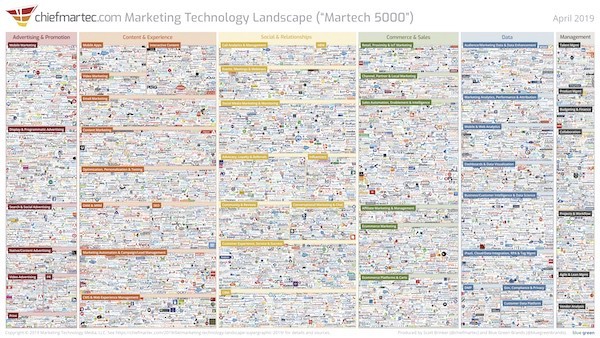
The yearly MarTech 5,000 supergraphic (albeit closer to 7,040 in April 2019) shows us that for every marketing problem, there is at least ten solutions to solve it. Multiply that by the number of probable (and likely) problems worth solving within an organization, and you’ve got a hefty little stack of software to proudly turn into a Powerpoint slide.
But what happens after you flip the switch? Once all this fancy marketing tech is turned on, what happens? I have an answer for you, 100% organic, fresh and still slightly damp from the secret underworld of SaaS.
Nothing happens — I mean, if you paid for a strategy consultant or implementation team, something might happen. If you have a great account manager, something might happen too. But nothing, and I mean absolutely nothing, happens by simply signing a contract and turning on a piece of software.
The success users find on most software platforms lies far outside of a fresh, clean and searchable UI; a few blocks past the fancy CSS animations on a website homepage; and way across town from that super sweet swag bag you received once you signed the dotted DocUSign.
Success begins with a clear, documented strategy — but where, do you dare to ask, does great strategy begin? Some platforms will give you a roadmap for success on their tech, treating you more like partners working toward the same outcomes. (This is a big green flag before signing a contract) Others, not so much. Inevitably, though, you are your brand’s subject-matter-expert for the big picture and how these tech solutions will connect you to the goals of your organization.
Strategy tactics can change depending on so many factors: if you’re B2B, B2C or B2R (Business to Robot. I’m telling you, it’s going to be huge someday); whether your team is looking to sell as much product as you can quickly or are more focused on gaining lifetime customers; or whether or not your brand is willing to truthfully listen to their customers and create an honest feedback loop that supports their strategy development moving forward.

^^ What I imagine you look like as you read “Business To Robot” in your head.
Remember — great strategy doesn’t happen overnight. Be agile as you develop your best practices.
There may be times where, at one point of the year, your best practice was the ideal workflow, but a few months later is found to be counter-productive in your day-to-day. Don’t be afraid to reconfigure (or even abandon) a process in exchange for a better way to work.
As the business changes, clearly documenting process inputs and outputs, as well as how these processes tie into the goals of your team, is essential to maintaining production frequency and scaling your teams. When others are able to clearly see the path from input to output to delivery on all major functions of the business, it creates better opportunities to map your processes and strategy to the functionality of technology solutions, gaining the best possible ROI situation for your investment.
So, as you go back to that Martech 7000-or-whatever to find the best solutions for your stack, consider the following:
- Software platforms will not automatically create results without a strategy in place — software platforms exist to help you execute that strategy.
- Your roadmap for success will differ depending on your business’ goals and outcomes — a solid understanding of your customers is critical.
- Great strategy takes time — be agile as you develop your best practices, and clearly document the path from input to output to delivery for a greater chance of success using marketing technology.

